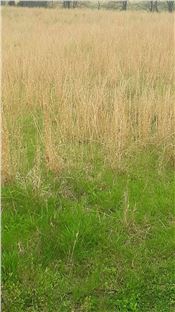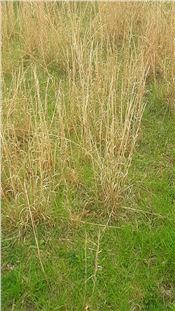Are The Greens In Your Pasture Tasty?
DR. TERESA L. STECKLER
SIMPSON, ILLINOIS
Spring is here – pastures grasses are greening up and calves are on the ground. Remember, forages need time to recover from their winter slumber before allowing too much grazing pressure. As these forages grow in your fields (pastures and hay fields), consider when you last assessed their condition. Questions you may want to ask yourself include:
a) What plants are present - their productivity and quality;
b) Are there weeds you do not want; c) Are they just annual weeds that are fairly easy to control, or perennial noxious weeds – like Canada thistle, Carolina horsenettle, etc. – that will require herbicide to get them under control. Many of these weeds are poor tasting, thus livestock will over graze pasture forages.
A prime example of a weed that can become problematic fairly quickly is broomsedge. Fields that have been invaded with broomsedge are easily identified right now by the straw-colored grasses that are 2 to 3 feet tall. I have seen fields with less than 10 percent coverage to fields that appearance of a wheat field. While broomsedge is a native plant, it is also a weedy grass commonly found in pastures and hay fields. Broomsedge is not a highly competitive species, but rather an opportunistic native plant that takes advantages of situations that decreases competitiveness of desirable forage plants. There are at least two conditions that favor broomsedge’s invasion of pastures or hay fields – poor soil fertility and inadequate grazing pressure.
When soil fertility and/or soil pH are not appropriate for active growth of desired forage plants, broomsedge often becomes a problem.
Pastures/hay fields depleted of nutrients or highly acidic soils create conditions unfavorable for growth of most forage crops. At the same time, these soil conditions favor growth and competitiveness of broomsedge, allowing it to overgrow and become problematic in pastures.
Inadequate grazing or defoliation pressure during the beginning of the growing season for broomsedge can also favor this plant. Cattle will actively graze it when it is producing young vegetative growth. Early in the growing season, it is quite palatable and continued defoliation at this stage will help decrease plant vigor. However, as it is allowed to mature, it becomes highly fibrous and unpalatable and cattle will not eat it. Inadequate defoliation pressure reduces stress on the plant while increasing stress on desirable forage plants. This creates a competitive advantage for the broomsedge.
A frequent question from livestock owners and hay producers is “how do I get rid of all this broomsedge?” The answer lies in soil health practices – soil fertility and grazing management.
The first step is taking soil samples. Sampling the soil allows you to review each field’s current soil health to know exactly what is recommended to apply for optimum forage growth. Generally speaking, if your fields have a significant coverage of broomsedge you will likely find that you are missing two key nutrients – phosphorus and calcium carbonate (lime). However, experience tells me that most of the time phosphorus is low in these fields.
Overgrazing of desirable forages also favors broomsedge. In many cases, there are still desirable forage species in broomsedge-infested pastures. In many pastures the desirable forages are cool season grasses; e.g. fescue. To encourage the growth of these desirable forage species, grazing management and soil fertility are crucial. You need to remove cattle at strategic times, especially during the summer months so the forage species can grow in late summer and fall.
Keep in mind that grazing management affects plant root growth and also the emergence of broomsedge. F.J. Crider in 1955 showed that when more than half of the forage is removed from a plant, root growth stops within the first day or two afterwards. The root growth remains stopped from 6 to 18 days, with an average of 11 days. So in your fields, if cattle have the opportunity to graze more than half of the top growth of a grass, at an interval less than 11 days, the roots never get to recover. If the roots don’t recover, then neither will the top. When this happens, broomsedge will have an opportunity to overtake your fields, diminish available desirable forages, and ultimately affect calf gains.
Other ways to manage broomsedge includes: 1) Clipping broomsedge in late summer or early fall once just before it produces seed to reduce shading of desirable forage species, making them more competitive in the stand; 2) After we clip pastures in late summer, applying 60 lb N/ A to stimulate desirable cool-season grasses helping to shift the forage composition away from broomsedge; 3) Kill the existing the pasture with nonselective herbicide and reseed it after improving soil fertility and grazing management (an expensive method); and/or 4) Feed hay on broomsedge-infested pastures as a low input way of increasing soil fertility over time by utilizing the nitrogen, phosphorous, and potassium (approximately 50, 15, and 60 lbs per ton, respectively) found in the hay.
Pastures don’t get in a poor condition overnight and they will not be fixed overnight either. Assess pasture/hay field soil health through the variety of plants found in those fields. If there are many undesirable plants, take action sooner rather than later. Controlling undesirable plants in pastures and hayfields will require a sustained effort of improving both soil fertility and grazing management. If broomsedge has crept into the fields, then make a plan, implement it, and over time you will see a reduction in broomsedge as your desirable forage species become more competitive. The length of time required to correct these infestations will vary greatly depending on the extent of defoliation and fertilization and the initial health of the established broomsedge. Happy grazing! ∆
DR. TERESA L. STECKLER: Extension Specialist, Animal Systems/Beef, Dixon Springs Agricultural Center

